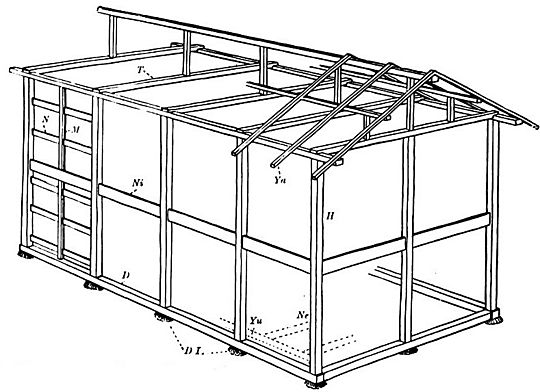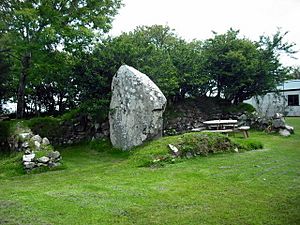Tŷ unnos facts for kids
Tŷ unnos (plural: tai unnos) is an old Welsh tradition. The name means "one night house" in English. This custom was also found in other parts of the British Isles. People believed that if you could build a house on common land in just one night, the land would then belong to you.
Some versions of the tradition added more rules. For example, you might need to have a fire burning in the fireplace by the next morning. Then, the person living there could claim land around the house. They could claim as much land as they could throw an axe from each of the house's four corners.
Contents
Why People Built One-Night Houses
From the 1600s to the early 1800s, the population in Wales grew a lot. Many people were also very poor. This led to many families building homes on isolated pieces of land. This practice was called squatting.
People did this because there wasn't enough land available. This was due to "land enclosure," where common lands were taken over. Also, old tax laws made it hard for families. Families had to pay taxes based on the land they lived on. If adult children wanted to build a second home, even on the same land, they faced extra taxes.
Legal Status of One-Night Houses

The idea of a Tŷ unnos was not part of official English law. However, there were some discussions about when land used by squatters could become their legal property. This old belief might have come from real local customs. It gave squatters a feeling that their actions were fair. They felt it followed older, fairer laws.
Many places in Wales and England have houses that locals call "one-night houses." These might be properties that squatters built long ago. They were often made using local materials. The Ugly House (Tŷ Hyll) in Snowdonia is a famous example of a Tŷ unnos.
Many stories about these houses are passed down. They often tell of a rich person making a bet with a family. If the family could build a house in a night and a day, they could keep the land. Some stories say the family might cheat a little. They might build a very small hut or just a fireplace to win the bet.
You can find a good overview of these traditions in the book Cotters and Squatters. The author, Colin Ward, writes about squatting and other ways people used land informally. He shares stories from England, Ireland, Scotland, and Wales. He also notes that similar traditions exist in other countries like Turkey, France, and parts of North and South America.
How One-Night Houses Were Built
We don't know many details about how these houses were built. We also don't know how many there were or who lived in them. Most Tai Unnos were first made from turf (grass and soil) and had a simple thatched roof. Once the house was set up, people often replaced the walls. They used local materials like clay and stone.
In 2006, someone built an experimental Tŷ unnos in Carmarthenshire. This showed that a basic structure could be put together very quickly. The people living in these houses didn't just farm. In some areas, they might have worked in quarries or mines. This led to the spread-out settlement patterns we see in the Welsh countryside today. Later, better materials like timber and slates became available. These could be brought in by new railways. Over time, many single-story Tŷ Unnos cottages were improved. Their roofs were raised, and windows were made larger.
The last known Tŷ unnos was built in 1882. Four brothers built it in Flintshire. The writer Oliver Onions wrote a fictional story about it in his 1914 novel Mushroom Town.
Modern Use of the "Tŷ Unnos" Idea

The "Tŷ unnos" idea has inspired modern housing. It is now used for low-cost, easy-to-build homes. A Welsh woodland charity called Coed Cymru named one of their house designs "Ty Unnos." This design uses local materials. In 2009, they were asked to show their design in Washington, D.C. It was part of the 2009 Smithsonian Folklife Festival, which featured Wales.
See also
- Gecekondu
- Shanty town
- Favela


